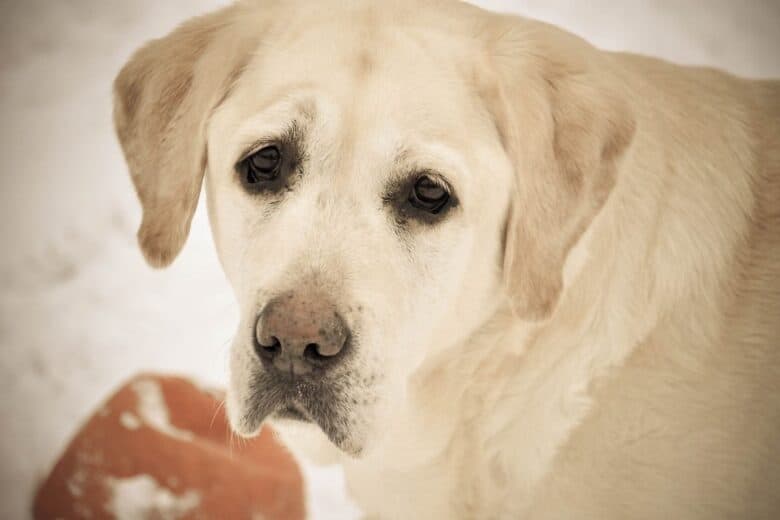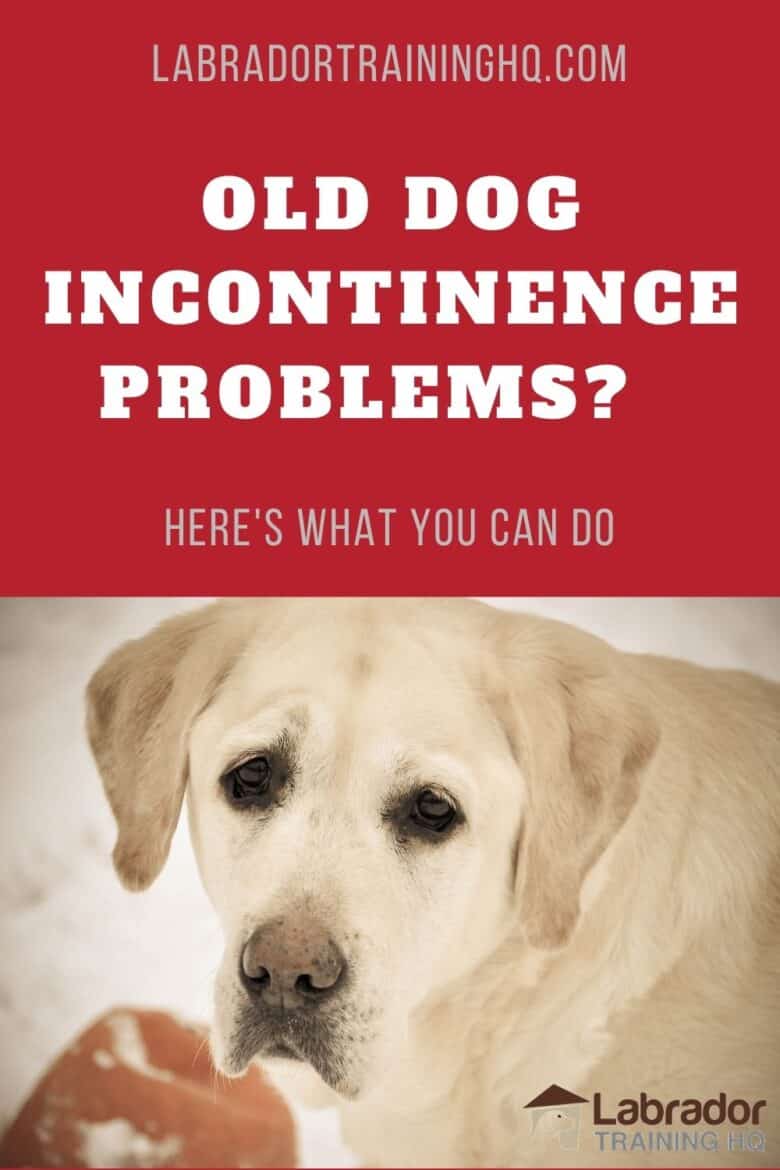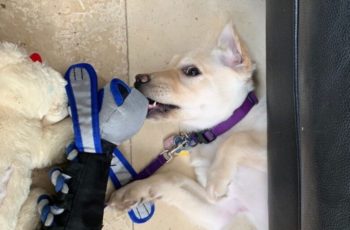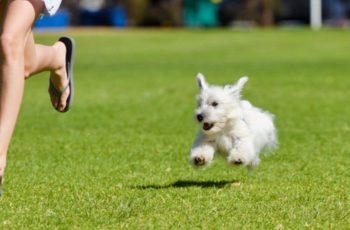This post may contain affiliate links. We may earn money or products from the companies mentioned in this post.
There are few things more frustrating than having to clean up dog urine inside your home. So, when your beloved family dog who has been with you for years becomes incontinent, it can be very disheartening.
But rest assured, true incontinence in dogs is highly treatable, even in older dogs, so your frustration may be short-lived.
However, if your older dog begins to forget their toilet training due to canine dementia, you may be in for a longer slog when it comes to managing their bathroom habits.
But there are many things you can do to support your dog, and prevent your home from smelling like urine.
Read on as we discuss canine incontinence: its causes, treatment, and simple things you can do to help manage the condition. We will then look at what to do if your senior dog forgets their toilet training for other reasons.
Contents & Quick Navigation
Incontinence In Older Dogs
The technical definition of incontinence is the involuntary leaking of urine from your dog’s bladder. It is not the same as your dog being disoriented and peeing in the house, something that we will deal with further down.

While any dog might develop incontinence, it is most common in female dogs that have been spayed.
It happens most often when they lose control of the neck of their bladder, which means that it is not fully closed and urine can therefore leak out. This is thought to be the cause of 80 percent of canine incontinence cases.
The leakage is, by definition, uncontrollable, and your dog is probably not even aware that it’s happening.
So there is no point in getting angry at them. It is not a behavioral issue and there is nothing they can do to prevent the urine from seeping out.
There are many things that can cause your senior dog to develop incontinence. Among the most common causes are:
- Bladder and urethra problems
- Hormonal fluctuations
- Infections
- Medication reaction
- Spinal and neurological problems
- Stress and anxiety
You will need to consult your vet to determine the cause of your dog’s incontinence.
Signs Of Incontinence
You might think the most obvious sign that your dog has developed incontinence is discovering puddles of pee around the house. But that’s not really how incontinence works.
When your dog needs to pee, they will follow their toilet training as normal. When pee leaks out in the house, it is because the bladder is not secure and the liquid just leaks out.
So, you are unlikely to notice large puddles of pee around the house unless your dog’s condition is already very severe.
The early signs of canine incontinence are more subtle:
- In the morning, there will be a damp patch on the bed where they have been lying
- They will feel damp around the legs, especially if they have longer hair because this takes longer to dry
- There will be a persistent smell of urine around your dog, their bedding, or both
- There can be scaling of the skin around their hind section, as it is in constant contact with urine
- They will have a tendency to lick themselves around the hind area more than is usual
These incontinence problems may come and go for several months before your dog develops chronic incontinence.
Treatments For Incontinence
Involuntary incontinence in dogs is actually highly treatable in most cases, though the exact treatment depends on the cause.
But this does mean there is light at the end of the tunnel for most dog families if their senior dog starts to develop incontinence.
Phenylpropanolamine, also known as PPA, is a medication widely used to manage incontinence in dogs, as it helps battle poor muscle tone in the bladder area.
If your vet prescribes this medication, it should start working within a few weeks.
If a hormone imbalance is the suspected cause of the incontinence, then your dog will probably need to undergo a bout of hormone therapy to restore them to proper levels.
This is effective but not cheap, as it requires frequent blood work to monitor their hormone levels and detect any potentially negative side effects.
If the cause of your dog’s incontinence is a bladder or urinary tract infection, then your doctor may recommend a change in their diet in order to prevent the infection from recurring.
Their new diet should be high in probiotics and omega fatty acids to help stave off future infections.
Most dog foods specifically designed for senior dogs contain the necessary supplements. Check out our recommendations for the best senior dog foods and our guide on proper nutrition for elderly Labradors.
If these treatments don’t work, your vet may recommend surgery. The most common surgery is a colposuspension, which involves injecting a pulling agent such as collagen into the urethra to help the urine flow more freely.
What You Can Do
It may take some time to treat your dog’s incontinence, but there are things you can do in the meantime to help keep your dog comfortable, and help keep your home from constantly smelling like dog urine.
First and foremost, let them go to the bathroom regularly. If their bladder is as empty as possible, they won’t have much liquid inside waiting to leak out.
You should also be sure to wash their hind section regularly to deal with the smell, and ensure that their skin does not become burned or otherwise irritated by being in constant contact with urine.
You will probably want to adjust their bedding. Certainly you will want something that is removable and washable. Fabrics that draw liquids away from your dog’s skin are also beneficial, as they will feel more comfortable.
If your dog has fairly heavy leakage, you might also want to consider doggy diapers. However, this is more for day use. You won’t want to leave your dog to sleep in a soiled diaper.
There are different types of diapers for male and female dogs. Male dogs will wear wraps that go around their belly and capture the urine they spray toward their stomach.
Diapers for female pups look more like human diapers, but with a hole to accommodate the tail.
Best Dog Diapers For Incontinence
There are lots of different dog diapers on the market, for male and female pups, and both disposable and reusable. But if you are looking for good-quality diapers, here are some of the best brands you can choose from.
Note that if you want diapers for fecal matter, you will need a different kind of dog diaper. You can read more about them here.
1. All-Absorb
All-Absorb offers disposable diapers, both wraps for male dogs and full diapers for female dogs. They also offer training pads that can be used with bedding to help keep them dry at night.
Their range comes in five sizes, which can accommodate anywhere from toy-size dogs to giant breeds. They all use fur-safe closure, so you don’t have to worry about the diapers pulling on your dog’s coat uncomfortably.
The diapers are all designed not to leak, and have a color indicator that lets you know when the diaper is wet and it is time for a change.
2. OUT!
OUT! also offers a range of disposable diapers for both male and female dogs, along with their range of cleaning products to deal with dog urine stains and odors.
The diapers only come in three sizes, but they are highly adjustable for finding a leak-proof fit. The fabric is moisture-wicking, which keeps your dog as dry and comfortable as possible.
The diapers include a baking soda agent that neutralizes the smell of urine for a happier home, but a moisture indicator will still let you know when your pup needs a change.
3. Pet Parent
If you are looking for more environmentally friendly washable diapers, then consider Pet Parent, which has reusable diapers for both male and female pups.
They come in five sizes, for dogs with a waist girth as little as four inches to big dogs with a 35-inch waist.
The diapers contain a super-absorbent pad that won’t leak, within a comfortable design. Once they have been used, rinse thoroughly and then machine wash. They are durable enough to last through hundreds of washes.
4. Pet Magasin
Another reusable diaper option for both male and female dogs, these padded options from Pet Magasin are both effective and comfortable.
Available in four sizes, they match an absorbent inner layer with a waterproof outer layer that won’t make the crinkling sound of disposable diapers.
The liner is good enough to deal with even big liquid spills. Simply rinse thoroughly and machine wash to refresh and reuse.
Other Types Of Senior Dog Incontinence
While the term incontinence specifically refers to the involuntary leakage of urine, the term is often used to refer to anything that causes your dog to start peeing or pooping in the house in old age.
Assuming that your dog has always been properly house trained and that this is a new development, there are a variety of potential causes.
First, dogs do lose bladder control as they get older, so they simply may not be able to hold it for as long as they used to. So, if they don’t get to go outside often enough, they may have to resort to peeing in the house.
You will probably know if this is the problem, as they will likely cry at the door or otherwise indicate that they want to go out before peeing.
This isn’t treatable, but it is manageable with some lifestyle changes.
Your dog needs to be let out to do their business more often, and you need to consider their liquid intake in the evening so that they don’t wake up in the middle of the night with a full bladder.
Stress and anxiety might also cause your dog to change their bathroom habits. This can be challenging to diagnose, but consider things that may have happened that could be affecting your dog.
Have you introduced a new pet to the home, moved to a different house, or has someone disappeared from the household?
The best thing you can do in this case is to take steps to make them feel safe and loved at home. Revisiting their house training can also help.
The final primary cause of this kind of incontinence in older dogs is also the most challenging: dog dementia. This means they simply forget their house training, and the same condition will make it very difficult to train them again.
There is no treatment for dog dementia, and so it will be more a case of managing the condition.
This will include giving them regular bathroom breaks and actively encouraging them to go while they are outside, as well as controlling their food and liquid intake in the evening.
You may also want to invest in dog diapers to manage mess during difficult times of the day.
If you need help removing pet stains and odors, read our guide here.
FAQs
What Can You Do For Old Dog Incontinence?
Incontinence, as in involuntary leakage of urine from the bladder, is actually highly treatable.
Depending on the cause, medication or hormone therapy can quickly resolve the problem within a few weeks or months. If this does not work, surgery is also an option.
A change in diet can also help prevent the kinds of illnesses that are likely to cause recurrent incontinence in older dogs.
However, if your dog is not incontinent but has suddenly started to voluntarily pee inside the house, this is more difficult.
This is often the result of dog dementia, which causes them to forget their house training.
Their diminished cognitive function also means that it is difficult to retrain them. When this happens, it is more about managing the problem, as there is no cure
What Are The Signs Of Incontinence In Dogs?
While you might think it would be obvious if your dog is incontinent, the condition often begins with minor leakage, which is not always immediately identifiable.
The first giveaway will probably be the smell of urine around your dog or their bedding.
If you notice this, you should check their bedding for wet stains, and also check to see whether their hind section is wet, where urine may have soaked into their coat.
If your dog is struggling with incontinence, you will also probably notice them licking their hind section more than is usual for most dogs.
Is Incontinence A Reason To Put A Dog Down?
Incontinence alone is not a reason to put your dog down, and true canine incontinence is highly treatable.
Most cases of involuntary leakage from the bladder is treatable using medication or hormone therapy, and may clear up within a few weeks. If not, surgery is then an option.
However, if your dog starts voluntarily peeing in the house, this can be another question.
This is not generally a sign of incontinence but rather cognitive dysfunction, which means they are no longer able to remember their house training.
Whether this cognitive dysfunction is a reason to put your dog down depends on its severity. It is all about monitoring their quality of life.
As long as they seem happy, there is no reason why they cannot continue to live a fulfilling life.
But if the memory loss results in them feeling constantly scared, or being in danger of seriously hurting themselves, you may need to discuss your options with your vet.
The Verdict
Incontinence in dogs, even senior dogs, is actually highly treatable. Involuntary leakage from the bladder is often the result of weakening of the muscles in the area.
Medications and other treatments can fortify those muscles and stop that unfortunate leakage.
The condition is also fairly manageable by giving them plenty of bathroom opportunities, monitoring their liquid intake at night, and using absorbent pads within their bedding, the location where puddles of pee are most likely to appear.
However, if your dog starts voluntarily peeing in the house, this is not incontinence but usually a symptom of another condition such as extreme stress or dog dementia.
These are conditions that are much more difficult to treat, and your options really depend on the cause.
But always remember, dogs do not pee in the house out of spite. They just don’t think that way.
So never get mad at a dog or punish them. It certainly won’t help, and if the problem is caused by stress or anxiety, it may even make the problem worse.
Have you dealt with an incontinent dog?
Share your experience with the community in the comments section below.
Save To Pinterest

Top Picks For Our Dogs
- BEST PUPPY TOY
We Like: Snuggle Puppy w/ Heart Beat & Heat Pack – Perfect for new puppies. We get all of our Service Dog pups a Snuggle Puppy. - BEST CHEW TOY
We Like: KONG Extreme – Great toy for heavy chewers like our Labrador Retrievers. - BEST DOG TREATS
We Like: Wellness Soft Puppy Bites – One of our favorite treats for training our service dog puppies. - BEST FRESH DOG FOOD
We Like: The Farmer’s Dog – A couple months ago we started feeding Raven fresh dog food and she loves it! Get 50% off your first order of The Farmer’s Dog.
For a list of all the supplies we get for our new service dog puppies check out our New Puppy Checklist on the PuppyInTraining.com blog.
What You Can Do About Old Dog Incontinence was last modified: March 2nd, 2021 by


